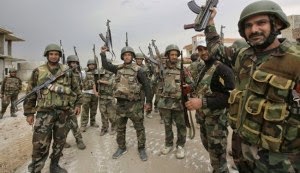 Tony Cartalucci
Tony Cartalucci
Activist Post
Syrian forces have edged closer to restoring order across the pivotal Syrian city of Homs in recent weeks, in tandem with other major gains being made across the rest of Syria. Encircled and depleted terrorist forces appear demoralized and have even begun turning on one another as attempts by their foreign sponsors to regain the initiative have failed utterly in both diplomatic and strategic terms.
The western city of Homs – Syria’s third largest city, located near the northern Lebanese-Syrian border – has served as one of several major battlegrounds between foreign-backed terrorists and Syrian security forces over the past 3 years. Militants were armed and arrayed against Syria using Lebanese territory under the auspices of the Hariri-Siniora political faction beginning as early as 2007, years before the so-called “Arab Spring” unfolded.
Pulitzer Prize-winning journalist Seymour Hersh stated in his thorough 2007 report titled, “The Redirection,” that (emphasis added):
The United States has also given clandestine support to the Siniora government, according to the former senior intelligence official and the U.S. government consultant. “We are in a program to enhance the Sunni capability to resist Shiite influence, and we’re spreading the money around as much as we can,” the former senior intelligence official said.
The report would also state (emphasis added):
American, European, and Arab officials I spoke to told me that the Siniora government and its allies had allowed some aid to end up in the hands of emerging Sunni radical groups in northern Lebanon, the Bekaa Valley, and around Palestinian refugee camps in the south. These groups, though small, are seen as a buffer to Hezbollah; at the same time, their ideological ties are with Al Qaeda.
Clearly these Western-funded, Lebanese harbored terrorists served as the backbone of one of three main foreign incursions into Syrian territory – the other two being through Jordan and into the Syrian city of Daraa and from Turkey into the city of Aleppo. Homs, however, is geographically located such as to benefit from both logistics originating in northern Lebanon as well as networks fed by Turkey-based terrorists in the north. Should the strength of terrorists in Homs wane, it would be indicative of not one, but two collapsing terrorist fronts and the diminishing resolve of their Western and Arab patrons.
 Should Homs be finally taken from occupying terrorist forces, it would signify a much larger shift in favor of Syria toward restoring order across the rest of the nation.
Should Homs be finally taken from occupying terrorist forces, it would signify a much larger shift in favor of Syria toward restoring order across the rest of the nation.
Syrian Arab Army Poised to Liberate Homs
Homs has been passed off by the Western media as the symbolic capital of the so-called “revolution.” Its liberation by the Syrian Arab Army would therefore be not only a tactical and strategic victory, but an immense psychological and political gain for Damascus as well.
In recent weeks, such a victory has come visibly within Damascus’ reach. Thousands of civilians and fighters were granted safe passage out of the Old City of Homs, leaving behind a depleted and encircled handful of fighters. Despite a brief attempt by the Western media to portray a “counteroffensive” as being underway in the city, it is now admitted that the collapse of terrorist forces in Homs is imminent.
The Associated Press in their article, “Syrian rebels make last stand for Homs,” reported that:
Syrian rebels are making a last desperate stand in Homs, as forces loyal to president Bashar al-Assad launch their harshest assault yet to expel them from the city once known as the capital of the revolution. Some among the hundreds of rebels remaining in the city in the centre of the country talk of surrender, according to opposition activists there yesterday.
Others have hit back with suicide car bombings in districts under government control. Some fighters are turning on comrades they suspect want to desert, pushing them into battle.
“We expect Homs to fall,” said one activist. “In the next few days, it could be under the regime’s control.”
Advances in Homs are mirrored elsewhere across the country as the West’s covert war against Syria slowly and irreversibly unravels – a process which began early in 2013 with terrorists being effectively countered from Damascus to Daraa, and along Syria’s borders with Lebanon.
 Defeat of West’s Covert War in Homs Reflects Greater Overall Decline
Defeat of West’s Covert War in Homs Reflects Greater Overall Decline
Recent revelations that the August 2013 chemical attack in Damascus was in fact carried out by NATO and its Arab partners, reveals just how far this unraveling has progressed. The failure of the attack to justify direct Western military intervention indicates a much larger problem for the West – one of credibility that is effecting its agenda from Syria to Iran, across Eastern Europe including Ukraine, and amid its attempts to “pivot” toward Asia.
With the West’s terrorist proxies being pushed out of one city after another across Syria, and with the West’s previously formidable media machine now seemingly impotent, options are becoming increasingly limited not only in Syria, but across the rest of the Middle East and beyond.
A recent New York Times column titled, “Homs Emerges as Turning Point in Shaping Syria’s Future,” sets the tone for how the West will handle its inevitable defeat in Syria. It disavows the prominent role the West and its Arab partners have played in funding, arming, training, and staging terrorists along the borders of Syria, purposefully fueling the destructive conflict that has rendered cities like Homs devastated. It also attempts to propose that the rebuilding of Syria should include the Western-backed opposition that carried out the deadly and costly conflict on behalf of its foreign sponsors and their designs of regime change as part of desired regional geopolitical reordering.
For Syria and its allies however, regardless of the narratives penned by the Western media and espoused from the podiums of Western politicians, the process of rebuilding and reconciliation will be entirely theirs to decide. Such rebuilding and reconciliation will most likely reflect the same patience and perseverance exhibited throughout the last three years of Western subversion, provocations, and acts of war visited upon the besieged Middle Eastern nation.
Tony Cartalucci, Bangkok-based geopolitical researcher and writer, especially for the online magazine “New Eastern Outlook”, where this article first appeared.


Be the first to comment on "Syrian Conflict: The Battle for Homs"